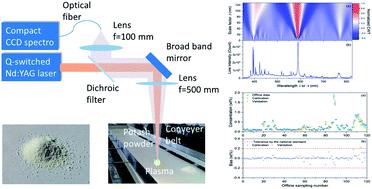当前位置:
X-MOL 学术
›
J. Anal. At. Spectrom.
›
论文详情
Our official English website, www.x-mol.net, welcomes your
feedback! (Note: you will need to create a separate account there.)
Online simultaneous determination of H2O and KCl in potash with LIBS coupled to convolutional and back-propagation neural networks
Journal of Analytical Atomic Spectrometry ( IF 3.1 ) Pub Date : 2020-11-27 , DOI: 10.1039/d0ja00431f Long Zou 1, 2, 3, 4 , Chen Sun 1, 2, 3, 4 , Mengting Wu 1, 2, 3, 4 , Yuqing Zhang 1, 2, 3, 4 , Zengqi Yue 1, 2, 3, 4 , Weijie Xu 1, 2, 3, 4 , Sahar Shabbir 1, 2, 3, 4 , Fengye Chen 1, 2, 3, 4 , Bin Liu 3, 4, 5 , Wenhui Liu 3, 4, 5 , Jin Yu 1, 2, 3, 4
Journal of Analytical Atomic Spectrometry ( IF 3.1 ) Pub Date : 2020-11-27 , DOI: 10.1039/d0ja00431f Long Zou 1, 2, 3, 4 , Chen Sun 1, 2, 3, 4 , Mengting Wu 1, 2, 3, 4 , Yuqing Zhang 1, 2, 3, 4 , Zengqi Yue 1, 2, 3, 4 , Weijie Xu 1, 2, 3, 4 , Sahar Shabbir 1, 2, 3, 4 , Fengye Chen 1, 2, 3, 4 , Bin Liu 3, 4, 5 , Wenhui Liu 3, 4, 5 , Jin Yu 1, 2, 3, 4
Affiliation

|
We demonstrate in this work online in situ characterization of potash fertilizer, a powder material, at its final production stage in factory on the production conveyer belt for quality assessment, with a specifically developed laser-induced breakdown spectroscopy (LIBS) instrument and dedicated data treatment software based on machine learning. Besides the usual difficulties encountered in online LIBS analysis, the specific challenge resides in moisture variation in the product, which results in a complex sample of powder of particle size ∼100 μm mixed with water (H2O). The influence on the LIBS spectrum was clearly observed, while no detailed physical model is available to describe such an influence. In addition, the emission line intensity from hydrogen (Hα line) observed in the spectrum did not show a clear relationship to the H2O concentration. The approach of analysis by correlation of the whole spectrum to the concentration was used to first determine the H2O concentration, which was further used as an additional parameter to concatenate with a LIBS spectrum in the formation of a generalized spectrum. The last was used as the input vector to train a potassium chloride (KCl) concentration calibration model. More specifically, LIBS spectra were first transformed into 2-D images with continuous wavelet transform (CWT). A convolutional neural network (CNN) then allowed mapping of the spectrum-images to the H2O concentrations of the corresponding samples, while a back-propagation neural network (BPNN) mapped generalized spectra to the KCl concentrations of the samples. The tests with online LIBS spectra and the corresponding offline analysis data of 119 samples taken during the period of LIBS measurements demonstrate advanced analytical performances of the trained models for H2O and KCl. Comparison between the model-predicted concentrations and the data from the offline analysis shows determination biases which fulfil the requirements of the concerned national standards (bias ≦0.20% for H2O and ≦0.598% for KCl) for the quasi totality of the tested samples.
中文翻译:

结合卷积和反向传播神经网络的LIBS在线同时测定钾肥中的H2O和KCl
在这项工作中,我们使用专门开发的激光诱导击穿光谱仪(LIBS)仪器和专用数据处理技术,在工厂的最终生产阶段通过生产传送带在工厂的最终生产阶段在线演示了钾肥(一种粉末材料)的特性,以进行质量评估。基于机器学习的软件。除了在线LIBS分析中通常遇到的困难外,具体挑战还在于产品中的水分变化,这会导致形成粒径约100μm的粉末与水(H 2)混合的复杂样品O)。清楚观察到了对LIBS光谱的影响,而没有详细的物理模型可用来描述这种影响。另外,在光谱中观察到的来自氢的发射线强度(Hα线)与H 2 O浓度没有明确的关系。通过将整个光谱与浓度相关联进行分析的方法首先用于确定H 2O浓度,在进一步形成广义光谱时,还用作LIBS光谱的附加参数。最后一个用作输入向量,以训练氯化钾(KCl)浓度校准模型。更具体地说,首先将LIBS光谱通过连续小波变换(CWT)转换为二维图像。卷积神经网络(CNN)然后允许将光谱图像映射到H 2相应样品的浓度为O,而反向传播神经网络(BPNN)将广义光谱映射到样品的KCl浓度。在LIBS测量期间,使用在线LIBS光谱和119个样品的相应离线分析数据进行的测试证明了训练后的H 2 O和KCl模型的高级分析性能。通过模型预测的浓度与离线分析数据的比较,可以得出满足相关国家标准要求的测定偏差(H 2 O的偏差≤0.20%,KCl的偏差≤0.598%)。 。
更新日期:2020-12-16
中文翻译:

结合卷积和反向传播神经网络的LIBS在线同时测定钾肥中的H2O和KCl
在这项工作中,我们使用专门开发的激光诱导击穿光谱仪(LIBS)仪器和专用数据处理技术,在工厂的最终生产阶段通过生产传送带在工厂的最终生产阶段在线演示了钾肥(一种粉末材料)的特性,以进行质量评估。基于机器学习的软件。除了在线LIBS分析中通常遇到的困难外,具体挑战还在于产品中的水分变化,这会导致形成粒径约100μm的粉末与水(H 2)混合的复杂样品O)。清楚观察到了对LIBS光谱的影响,而没有详细的物理模型可用来描述这种影响。另外,在光谱中观察到的来自氢的发射线强度(Hα线)与H 2 O浓度没有明确的关系。通过将整个光谱与浓度相关联进行分析的方法首先用于确定H 2O浓度,在进一步形成广义光谱时,还用作LIBS光谱的附加参数。最后一个用作输入向量,以训练氯化钾(KCl)浓度校准模型。更具体地说,首先将LIBS光谱通过连续小波变换(CWT)转换为二维图像。卷积神经网络(CNN)然后允许将光谱图像映射到H 2相应样品的浓度为O,而反向传播神经网络(BPNN)将广义光谱映射到样品的KCl浓度。在LIBS测量期间,使用在线LIBS光谱和119个样品的相应离线分析数据进行的测试证明了训练后的H 2 O和KCl模型的高级分析性能。通过模型预测的浓度与离线分析数据的比较,可以得出满足相关国家标准要求的测定偏差(H 2 O的偏差≤0.20%,KCl的偏差≤0.598%)。 。











































 京公网安备 11010802027423号
京公网安备 11010802027423号